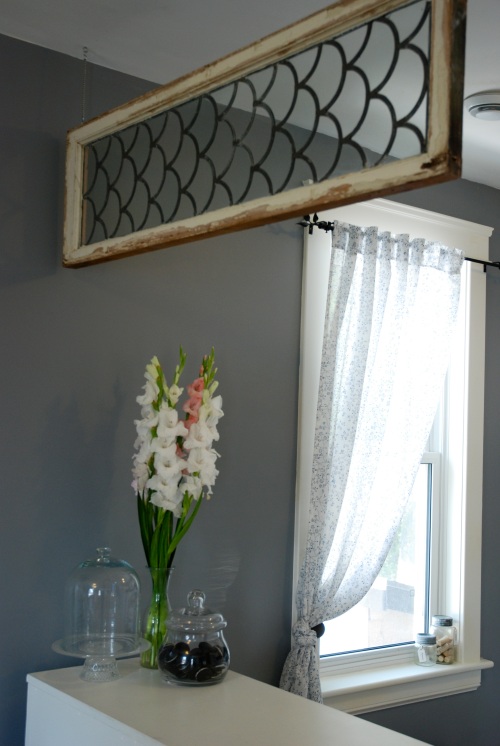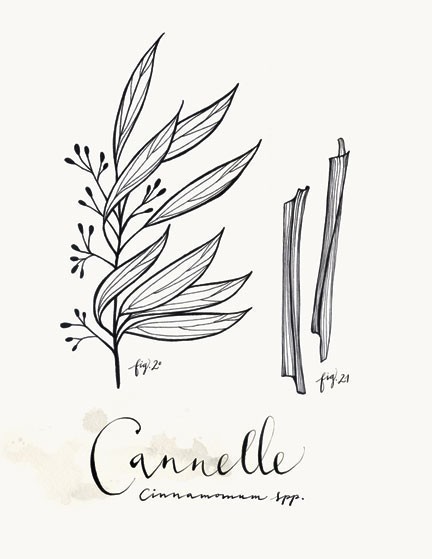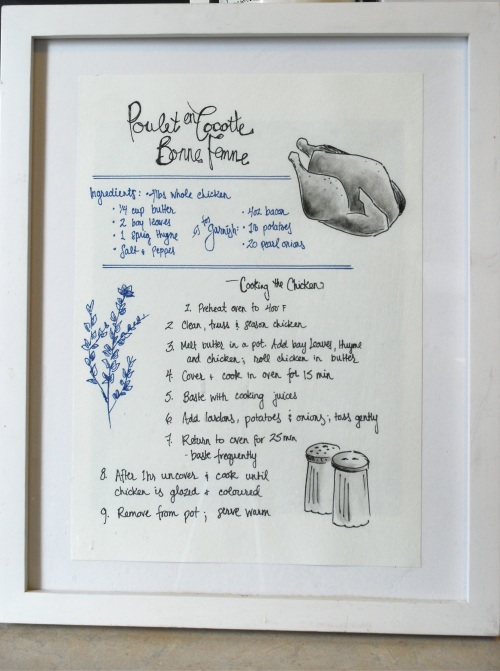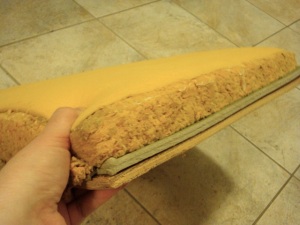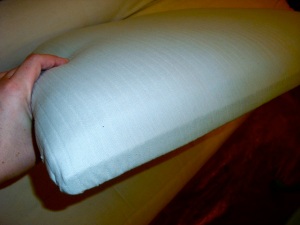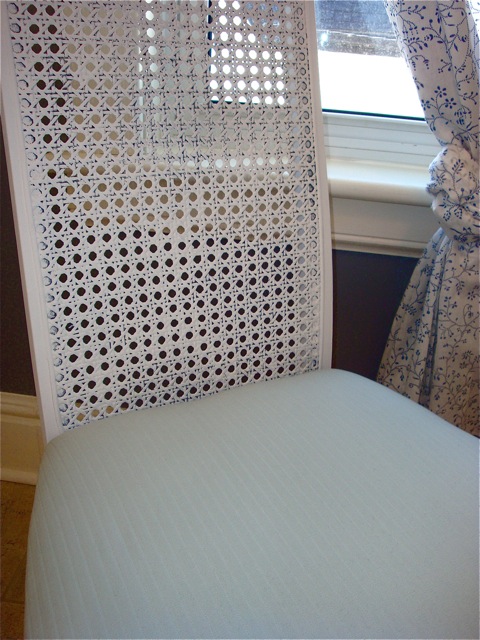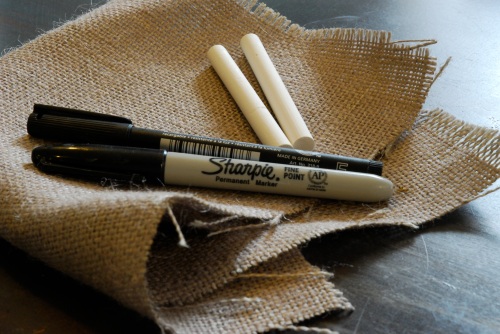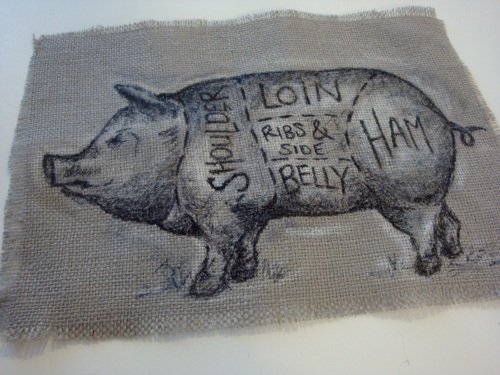The 0h-so-of-the-moment ‘Numbered Kitchen Stools’!
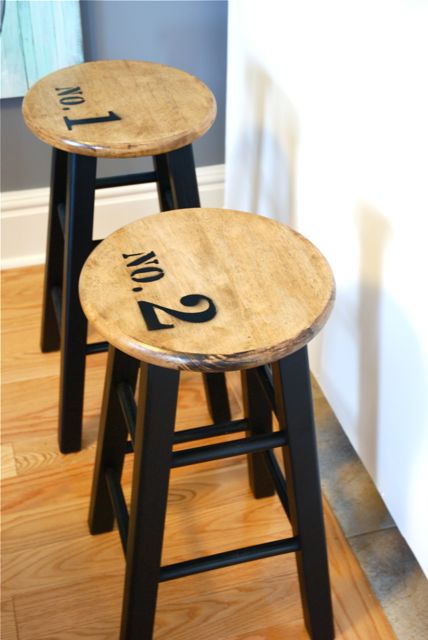
With an open concept home like ours, the dining area flows into the ‘living room’ which flows into the kitchen. I find it’s important that each area has it’s own points of interest and style, but that overall the whole concept works together. When we moved into our apartment, we found that the kitchen flowed into the living space a little” too freely”, ie. there was nothing to define where the kitchen began and the living room ended, other than some not-so-hot tile flooring. So when we finally found an old side board that would double as a kitchen counter island, it was a pretty great day! The space was divided! And it looked phenomenal. Now we not only had flow, we had division. It was perfect.
With the island taken care of, I knew it was time for us to begin the search for some stools. I love getting up in the morning and being able to sit in the kitchen. It’s the best way to start the day. You can have a tea, read something, and eat your breakfast, and it’s all so easy to do, because you’re sitting at the kitchen counter. (As opposed to sinking into the couch; the couch is too similar to the bed, it makes we want to be back in bed).
A week of searching on Kijiji yielded zero results. However, my stars must have aligned this month, for it was time for the much much anticipated annual church community ‘yard’ sale. The entire church (and it is a big church) is filled with the patrons junk. Rooms upon rooms just bursting with treasure. I love it. I dream about this event. And yes, I take it very seriously. This year we went early and waited in line. Next year, we’ll probably set up camp and sleep over night so that we the FIRST people in the door. Now, as you’ve probably guessed, two simple yet perfect stools were found at the sale. At ten bucks each they weren’t super cheap, but I was fairly desperate. So for a crisp twenty I came home with two kitchen stools.

It was my first instinct to just enjoy them for awhile, but I decided to take them apart and get to work. Chris removed the seats and we worked with them like that, in two parts. First the seats had to be striped. The stools looked quite bare, but even the simplest wood pieces will have a coat of some sealant on them which makes it necessary to strip them in order to ‘start from the beginning’ with the wood and achieve the look you are after. So we got out the chemicals and the gloves and removed the sealant. It was fairly straight forward. We had some trouble running our very straight putty knives (which we use to lift up the paint/urethane etc from the wood) on the very round edges of the seats. But other than that, it was all good. Once we had removed the sealant, (think of it was the hard shiny surface), we cleaned the wood with a bit of paint thinner and steel wool and it was back to it’s simple perfect self. Not the most amazing grain ever, but it was wood and that was good enough. From there I put on one coat of dark walnut stain. I brushed it on, left it for just under twenty minutes and wiped it off with a clean dry cloth. The result was good, the wood soaked up a lot of the stain, and I was happy with the colour. Next came the design for the seat. I went through a few different ideas, but I decided to try out the ‘numbers’ trend. I’m sure you’ve seen evidence of this trend somewhere, numbered coffee mugs, chairs, coat hooks. It’s a fun trend because you can number anything! Endless possibilities.
I decided on a design and got to work. I had some industrial style letter stencils lying around so they were used for the ‘NO.’ and I printed the ‘1’ and ‘2’ out in large font on the computer (make sure if doing this to only print an outline so as not to waste ink). I carefully cut out the numbers and thus a stencil was created! From there I taped the whole design onto the stool using painters tape. A quick coat of my beloved ‘Flat Black’ Krylon spray paint and five minutes of dry time later and I was able to lift off my stencil and see the results! I was pretty impressed with the outcome, if I do say so…
The final step, was simply coating the the whole seat with a sealant. I waited twenty four hours after spray painting and used my stand-by sealer, the Minwax Water-based Polycrylic. One or two coats of that stuff (use a soft bristle brush or a sponge brush for best results) and you have a lovely hard surface with a great sheen. And of course, the wood is protected.
The seats were finished! Now it was time to focus on the bottoms of the stools. They were much more straight forward. I simply sprayed on a light coat of spray paint primer. I let the primer dry and then finished up with about three very light coats of Krylon Flat Black. I say three light coats because with spray paint it’s not about getting the entire surface covered in one go. Just spray lightly and if spots are missed, don’t worry, you’ll cover them with the next round. The problem with trying to spray everywhere in one round, is that while trying to paint the hard-to-get-to spots, you inevitably spray over other spots again and again. In those areas, the wet paint collects and starts to run and flow– and that’s when you get drips while spray painting. So just restrict yourself to light imperfect coats, and the result will be a perfect final product. I didn’t bother to seal the legs of the stools. The spray paint is fairly tough, and being legs they don’t get a lot of wear the way a seat does. Chris put the stools back together using a bit of wood glue and the original screws.
Here are my step-by-step photos instructions of the entire process:

The original stools. Perfect, in size and shape, but just a bit boring.

The stools after disassembly.

All the supplies needed for stripping the finish on the seats. Heirloom stripper, paint thinner, putty knife, mask, and heavy rubber gloves.

This is the product (Heirloom Furniture Stripper) that I use for stripping, I am always happy with the results.

I applied the stripper with a cheap bristle brush. After application, the chemicals must sit for a few minutes. The finish usually begins to lift very quickly.

When I saw the the finish begin to lift, I waited another minute and then began to scrape the finish off with a putty knife. (When finished, you may need to repeat the process from the beginning until there is no finish at all. Steel wool is also helpful in place of the putty knife, for those tricky spots). After all finish had been lifted, I dampened a clean cloth with paint thinner and wiped down the entire surface of the wood.

To stain the wood, I chose my stain colour (I used Minwax Dark Walnut here), then applied it to the unfinished wood with a brush. I like to use a bristle brush, others prefer a sponge brush, both work well. I let the stain sit for 15-20 minutes before wiping it off VERY thoroughly with a clean dry cloth.

For the stencil, I printed numbers (outlines only to save ink) in large font.

My makeshift stencil– all cut out and ready to use.

In addition to my homemade stencils, I also used simple craft stencils. The ‘design’ was carefully laid out and held in place with painters tape.

Here you can see the design taped in place.

I covered the exposed area with paper towel to keep it safe from spray paint overspray.

After spray painting, I waited a few minutes and then carefully removed the stencils and paper towel. This was the result!

I let the spray paint dry for 24 hours and then brushed on two coats of Minwax Water-based Polycrylic.

The legs after a light coat of spray paint primer.

The legs received about 3 light coats of Flat Black Krylon spray paint and then the stools were reassembled. Aren’t they pretty?

At last– the stools become a part of our place.

We have come to the end of this beautiful story of a girl and her kitchen stools! Or perhaps it is just the beginning…
 The $5 table. Scuffed, ugly and oh-so-70’s.
The $5 table. Scuffed, ugly and oh-so-70’s. A quick coat of grey primer and we’re off to a good start.
A quick coat of grey primer and we’re off to a good start. After priming I used two paints: White latex on the base of the table and Gold Krylon spray paint on the top.
After priming I used two paints: White latex on the base of the table and Gold Krylon spray paint on the top. All finished! Recap: Two coats of white latex paint on the body (lightly distressed with sand paper) / Gold spray paint on the top / Lovely hardware from Anthropologie! (Not my best photo, I know).
All finished! Recap: Two coats of white latex paint on the body (lightly distressed with sand paper) / Gold spray paint on the top / Lovely hardware from Anthropologie! (Not my best photo, I know). Let’s take a minute to appreciate that fabulous hardware! Two gold and opalescent knobs definitely helped to complete the piece.
Let’s take a minute to appreciate that fabulous hardware! Two gold and opalescent knobs definitely helped to complete the piece. Success! The table fits perfectly beside the bedroom sofa.
Success! The table fits perfectly beside the bedroom sofa. Of course, a table is never complete until is has been ‘dressed’. I found this to be a wonderful place to display my newly finished butterfly dome!
Of course, a table is never complete until is has been ‘dressed’. I found this to be a wonderful place to display my newly finished butterfly dome! A glass tray from Home Outfitters serves as a nice alternative to coaters.
A glass tray from Home Outfitters serves as a nice alternative to coaters. My latest find! A very very old framed etching of Notre Dame. (Only $20 at a junk shop- Score!) I can’t help myself when it comes to architectural artwork, especially if it’s le French! It’s always so beautiful. I also added some depth with a framed architectural photograph of my own: a black and white of St. James Cathedral on Church St. in Toronto.
My latest find! A very very old framed etching of Notre Dame. (Only $20 at a junk shop- Score!) I can’t help myself when it comes to architectural artwork, especially if it’s le French! It’s always so beautiful. I also added some depth with a framed architectural photograph of my own: a black and white of St. James Cathedral on Church St. in Toronto. The gigantic bedroom is coming together! Still looks a bit empty… I’ll be sure to let you know when I find a side chair!
The gigantic bedroom is coming together! Still looks a bit empty… I’ll be sure to let you know when I find a side chair!












